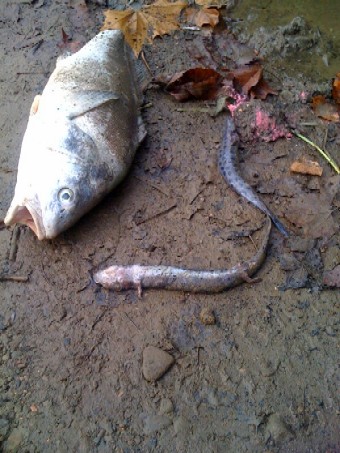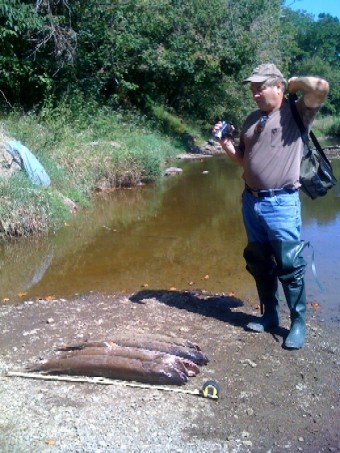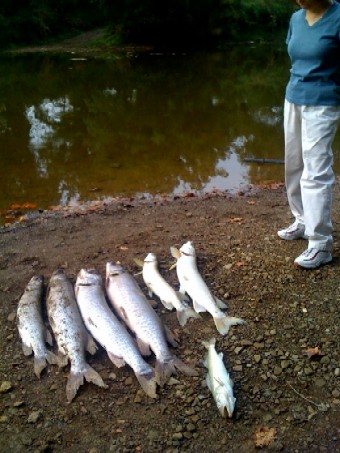DEP: Algae May Be Killing Fish
Officials say the algae could release toxins that kill the fish.
WBOY-TV - Clarksburg, WV
24 September 2009
Story by Jessika Lewis



Photo Credit: Submitted by Leonard George
The West Virginia Department of Environmental Protection is now
strongly considering algae as the source of a fish kill that started in
Dunkard Creek on September 1.
Algae experts at West Virginia University as well as from North
Carolina and Texas told DEP officials they think Prymnesium parvum or
golden algae is to blame, according a release from the agency.
This form of algae is normally found in coastal waters, the release
says, where the water has higher salt or mineral content.
It produces toxins that can affect gill-breathing fish, and the Dunkard
Creek fish kill is almost the same as those in other parts of the
country that have been caused by the algae, says the release.
“Narrowing down the cause will allow us and anyone who may be found to
be responsible to find a solution,” said Cabinet Secretary Randy
Huffman. “Some members of our investigation team are now turning their
attention to finding ways to minimize or eliminate the algae bloom. We
are also evaluating what can be done to prevent this from happening in
the future, in Dunkard and other watersheds.”
Although the DEP says its information indicates that this form of algae
does not cause health problems for humans, it is asking the public to
avoid transporting water from Dunkard Creek to other watersheds.
“While it appears that saline- and mineral-rich environments are
conducive to the growth of the golden algae in Dunkard Creek, we aren’t
sure if the algae was introduced into the creek or if it just
proliferated due to favorable conditions,” Huffman said. “It could have
been transplanted in a number of ways, including waterfowl, water
transport or even waders of fishermen who have fished in affected
waters in other states.”
DEP officials previously hypothesized that the Blacksville Number Two
mine was to blame, after detecting high levels of total dissolved
solids and chlorides on the West Virginia side of the border.
After CONSOL agreed to shut off discharge from the Blacksville Number
Two mine last week, another fish kill was spotted a mile and a half
upstream from the mine's discharge point, causing investigators to
question the mine as the sole source of the kill.
It is too early to determine whether discharge from the Blacksville
Number Two, or even leakage from an injection well operated by a CONSOL
subsidiary near the defunct Blacksville Number One mine had a part in
the kill, according to Kathy Cosco with DEP Public Relations.
CNX Gas Company LLC, the CONSOL subsidiary operating the well, received
$157,500 in administrative penalties from the EPA for failing to comply
with the parameters of its permit for the facility.
The company did not providing adequate staffing at the facility, submit
information to the EPA, or monitor the volume of waste coming from the
plant, according to the Administrative Order.
Those problems were already remedied, according to Hoffman.
"We corrected those shortcomings a year ago. I think what you've got
here is an order that's out there and people are doing their best to
connect the dots," Hoffman says.
One agency in Pennsylvania is asking environmental agencies
investigating the fish kill to aggressively pursue identifying the
waterways pollutant.
The Greene County Conservation District's Board of Directors passed a
resolution Tuesday night, asking that the agencies not abandon the
investigation until the source is established.
This isn't the only problem the watershed has had, according to Martin
Niverth, Research Associate for the Greene County Department of
Economic Development, of which the conservation district is a part of.
The creek has been plagued by industrial wastes, sewage problems, and a
history of acid mine drainage, according to Niverth.
Organizations had spent lots of money trying to improve the creek's
water quality, Niverth says, as well as the water quality in entire
Monongahela River.
One of the major contributors to the kill, according to Niverth, was
low water levels.
"It happened during a period of low flow, so what was in the water
became more concentrated," Niverth says.
Niverth also sites what he calls "the invasion of Marcellus shale
exploitation for natural gas" as a factor.
"This industry was going on in high gear and people didn't know what
was in the water," Niverth states.
Drilling for natural gas found in the Marcellus shale takes lots of
water, and Niverth says the area wasn't prepared for the amount of
water needed to run the wells drilling for the gas, and didn't know
what to do with the contaminated water afterwards.
West Virginia DEP officials acknowledged that they had received reports
from residents living near the creek saying they suspected trucks were
dumping wastewater from oil and gas drilling into Dunkard Creek.
"We have found that those trucks that have been reported are
withdrawing water from the stream, rather than dumping wastewater,"
says Michael Zeto, the DEP's Chief of Environmental Enforcement.
Drawing the water out of the creek could have caused harm as well.
"You can remove enough water from the creek to harm it, and it's a fact
that that has happened," Niverth says.


